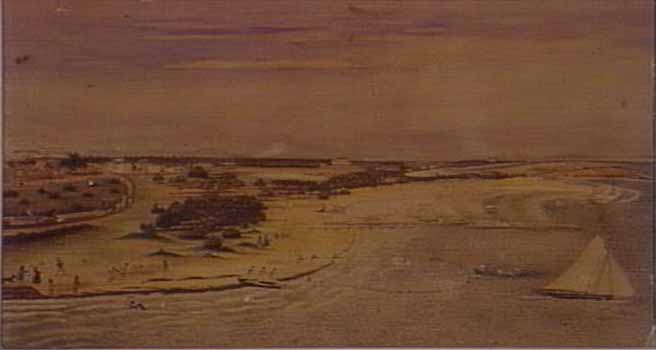The Artists
W.F.E.
Liardet
W.F.E. LIARDET
ST. KILDA FORESHORE AND POINT ORMOND, RED BLUFF, 1862

WILBRAHAM
FREDERICK EVELYN LIARDET
Born 1799 Died 1878
ST. KILDA
FORESHORE AND POINT ORMOND, RED BLUFF, 1862
painting: watercolour,
pencil, pen and ink on cream paper laid down on artist board
27.7 x 45.5cm
Collection: La Trobe Picture Collection
State Library of Victoria
St. Kilda is a bayside suburb of Melbourne, situated three kilometres south of the centre of Melbourne and stands on the north east coastline of Port Phillip Bay.
St. Kilda was originally named 'Euroyroke', an Aboriginal term meaning 'stone used for sharpening knives and spear heads'. Later the area was called Green Knoll and when Thomas H. Nutt first surveyed the town site in early 1842, the settlement was known as Fareham, after the English beach resort near Portsmouth. Eventually, Superintendent Lonsdale named the area St. Kilda after the yacht 'Lady of St. Kilda', that took its name from an island in the Hebrides. 'Lady of St. Kilda' belonged to Colonel Acland.
Yachting has always been an enjoyable pastime in this part of Port Phillip Bay, and Liardet depicts a large yacht sailing in the bay in this early watercolour. The watercolour also shows many of the other social activities that happened in St. Kilda at this time.
There are men fishing, hauling in a large seine net. There is a couple seated on a park bench watching the fishermen, while others go for a stroll along the beach. Others still are shown on the rise to the left, where there are soldiers and a variety of horse drawn vehicles.
The Woiwurung Aborigines are thought to have occupied the area before European settlement, and in this watercolour an Aborigine is shown on the beach demonstrating to the onlookers, how to throw a boomerang.
Liardet provides with a view towards the east, with the Red Bluff of Point Ormond to the south east clearly visible in the far right distance. Stationed atop the bluff is a tripod navigation marker.
Around 1888, Girolamo Nerli also painted the Red Bluff, Point Ormond, however his work, although from the same angle, was painted from much closer to the bluff.
Point Ormond, which was in the past also known as Red Bluff, was named after Captain Ormond of the sailing ship 'Glen Huntly". In April 1840, Captain Ormond landed at the point, rather than any closer to Melbourne, a group of typhus-infected migrants.
Point Ormond is in the suburb of Elwood, which was named after the English poet and historian, Thomas Ellwood, who was a close and devoted friend of blind poet, John Milton. Nearby Glen Huntly, adopted its name from Captain Ormond's sailing ship.
In Liardet's watercolour, the pier and baths are depicted beyond the fishermen and the fluttering red flag at the entrance of the baths, indicated that the baths were now available to gentlemen bathers. A white flag would welcome ladies.
By the 1890's, St. Kilda was said to have one of the finest esplanades in Australia, where 'either a first class bath in the sea or a bracing walk towards the Red Bluff awaits'. Although St. Kilda was not proclaimed a city until 2 December 1890, it was made a town in 1861, the year before this watercolour was produced.
By 1862 there was already substantial development in St. Kilda. The Village Belle Hotel was first licensed in 1855, the property 'Oberwyl', former home of John De Silva, was opened in 1856, and the Blessington Street Gardens were opened in 1859.
Liardet has managed to depict a number of the outstanding buildings of the area, including in the centre, inland from Red Bluff, the Elsternwick Hotel that was built in 1854. Elsternwick derived its name from the overlander, Charles Hotson Ebden, who named his house, 'Elster', the German for 'magpie'. During the 1850's, the creek nearby his house became known as Elster Creek, and later when a village, or wick, developed in the vicinity of the creek, the area became known as Elsternwick.
W.F.E. Liardet, watercolourist, hotel-keeper and military officer was born in Chelsea, London on 17 July 1799. In 1821, he married his cousin, Carolina Frederica Liardet, and by 1839, when the family sailed for Sydney aboard the 'William Metcalfe' Carolina had given birth to eleven children, of whom nine had survived infancy.
On the way to Sydney, the ship spent three weeks in Hobson's Bay, Victoria, and Liardet decided to settle there. He purchased a whale boat and began a business carrying mail ashore from ships. In August 1840, he started running a mail cart to and from Melbourne three times a day, and in October 1840 opened the Brighton Pier Hotel and began a passenger coach service to Melbourne.
Later, in 1874 he produced a watercolour of 'Liardet's Beach and Hotel in their Heyday' - in 1840. By 1862, Liardet would have been very familiar with this view of St. Kilda. In 1864, he published another bay scene, this time a lithographic 'View of the North Shore of the Port of Melbourne' which he dedicated to Governor, Sir Henry Barkly.
Soon after he left Australia and spent much of the next ten years living in New Zealand. He returned to Melbourne in 1874, and in 1875 painted forty scenes of early Melbourne.
He travelled to New Zealand in 1877, and died at Vogeltown, Wellington on 21 March 1878.
Another early view along the coast of St. Kilda is 'Coast scene, St. Kilda', painted by Thomas Clark in 1857.
Copyright
Notice
No works
can be copied from this site. Permission to publish or reproduce can be
sought from the
State Library of Victoria.
All Rights Reserved medialaunch Pty. Ltd.
Left: Arthur Streeton
- Above Us The Great Grave Sky, 1890
Collection: National Gallery of Australia, Canberra.
ABN 69 067 524 921
Tel: +61 3 98185700 Fax: +61 3 98185044
Email: editor@artistsfootsteps.com